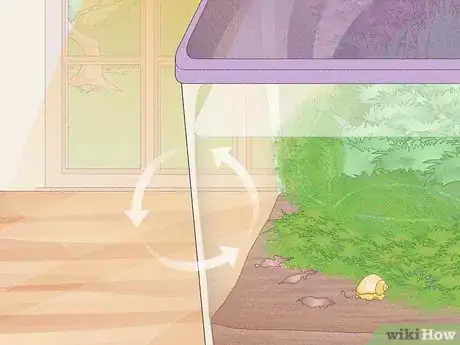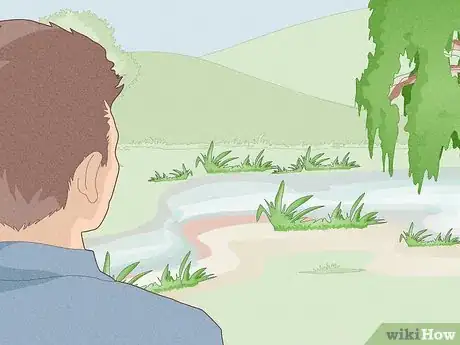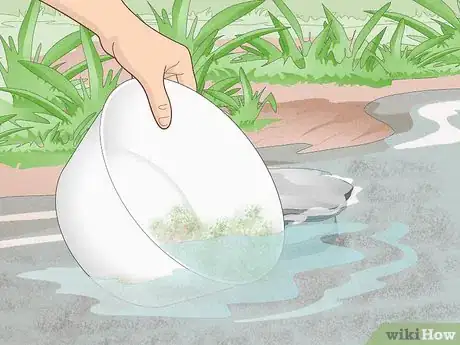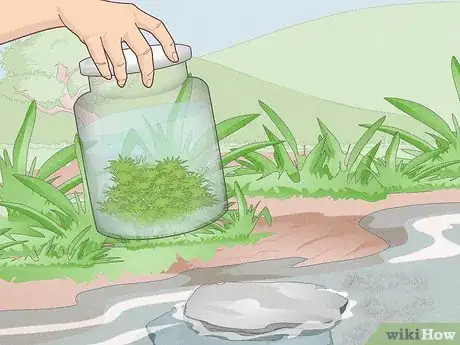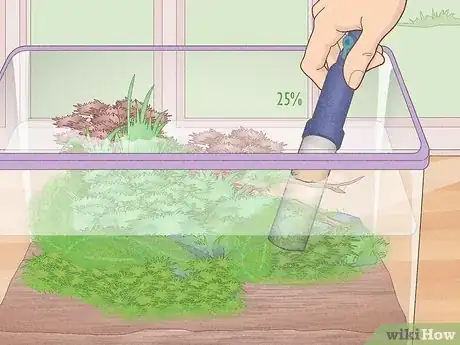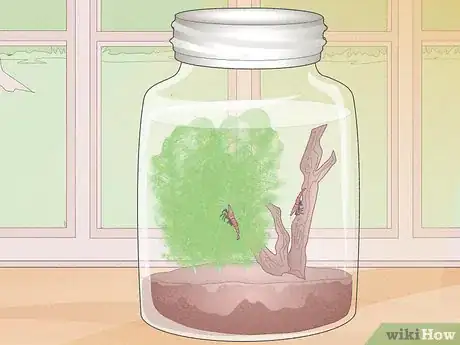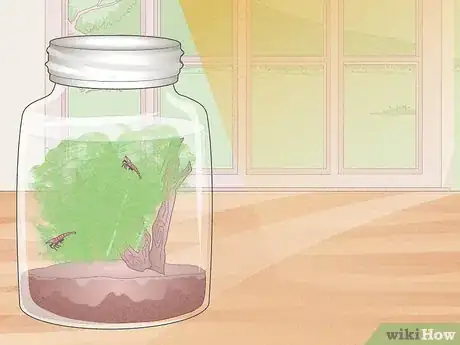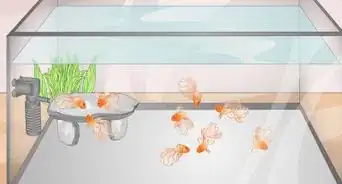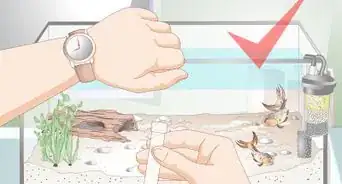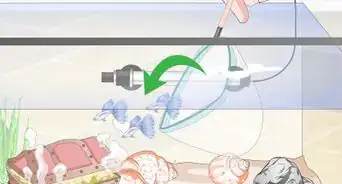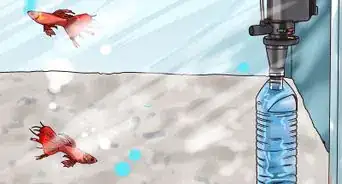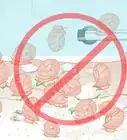This article was co-authored by Craig Morton. Craig Morton is the CEO of Aquarium Doctor Inc. based in Huntington Beach California and servicing Orange County, Los Angeles County, and the Inland Empire. With over 30 years of aquarium experience, Craig specializes in creating custom aquarium designs along with aquarium installation, service, and maintenance.
This article has been viewed 324,577 times.
If you’re looking for all of the fun of an aquarium without any of the work or mess, then a closed aquatic ecosystem may be right for you! They don’t need any food, cleaning, or anything other than enough sunlight. They’re also super simple to make. To make the process even easier for you, we’ve answered some of the most common questions that people have about what it takes to make a closed aquatic ecosystem.
Steps
What do you need to make a closed aquatic ecosystem?
-
1You need a clear, sealable container and some collection equipment. You can basically use anything that closes, but it needs to be clear so sunlight is able to get through (and so you can see the ecosystem). Mason jars, plastic containers, empty glass bottles, or even clear Christmas ornaments are all great to use. You’ll also want some gear like a large bowl, a spoon or ladle, and a suction device like a turkey baster to gather material for your ecosystem.[3]
-
2Choose a nearby pond, lake, river, or stream to collect materials. The best way to make your own closed aquatic ecosystem is to gather materials from an environment that is already established and thriving. Look for a nearby pond, lake, or waterway that you can visit to gather sediment, plants, and wildlife for your ecosystem.[4]
- If you try to gather dirt from your yard, water from a pond, and plants from your garden, your ecosystem won’t survive. You need to gather materials that already live together.
- Some waterways may be protected by conservation laws, so double check your local laws to make sure it’s okay for you to take water, sediment, and plant samples first!
How do you start a closed ecosystem?
-
1You can purchase one ready-made for a simple option. Miniature closed ecosystems were developed in the 1980s and are still available today. You can purchase a kit that comes with a glass globe, seawater, bacteria, gravel, coral, algae, and shrimp—already sealed inside. All you have to do is place the ecosystem in a sunny location and enjoy it![5]
- The most popular brand of miniature closed aquatic ecosystems is called EcoSphere. You can order them online and have them shipped directly to you. They usually last for about 2-3 years.
-
2Collect water, sediment, and plants from a freshwater source. Use a sealable container and equipment such as spoons and ladles to gather your materials from a nearby freshwater pond, lake, or waterway. Scoop some of the soil out of the water, add it into your container, and then fill the container with water and wait for the sediment to settle at the bottom. Then, gently remove some nearby plants growing in the sediment you collected and add them to your container by pushing their roots into the sediment. Leave a small pocket of air, and then seal the container.[6]
- You can then place the container somewhere nice and sunny such as a windowsill and enjoy your new closed aquatic ecosystem.
- It’s important that you collect water, sediment, and plants from the same location so they’ll survive together.
How do you make a closed aquatic ecosystem in a bottle?
-
1Put sediment and water first, then add plants and animals to the bottle. Choose a clean, clear bottle, collect sediment and water from a nearby lake, pond, stream, or another waterway. Wait until the sediment settles and then add plants you collect from the water source into the bottle. If you have aquatic shrimp, snails, or copepods, you can add them as well. Fill the bottle so there’s a small pocket of air and then seal it tight.[9]
-
2Place the bottle in a location with plenty of natural sunlight. Direct sunlight can damage and potentially destroy your closed aquatic ecosystem. Choose a sunny spot such as a shelf near a window or a windowsill and place your bottle there. That’s all there is to it![10]
Community Q&A
-
QuestionWhat if all of my animals need different climates?
 Community AnswerIf they need different climates, it is not a good idea to put them together.
Community AnswerIf they need different climates, it is not a good idea to put them together. -
QuestionWhat if I'm not able to feed the fish, but it needs to stay alive for a long while?
 Community AnswerYou could get a food source that can live and remain in the ecosystem for the fish. If you have herbivorous fish, get plants that they would eat. If your fish are carnivores, get several shrimp or minnows of opposite genders, and let them reproduce. Then, you will have a school of prey and a school of predators. Also, make sure there are places in your ecosystem for the prey fish to hide, so they don't all get immediately eaten.
Community AnswerYou could get a food source that can live and remain in the ecosystem for the fish. If you have herbivorous fish, get plants that they would eat. If your fish are carnivores, get several shrimp or minnows of opposite genders, and let them reproduce. Then, you will have a school of prey and a school of predators. Also, make sure there are places in your ecosystem for the prey fish to hide, so they don't all get immediately eaten. -
QuestionHow do guppies breed?
 Community AnswerAll you have to do is put the male and female together. Just make sure to separate the babies, so the parents don't eat them.
Community AnswerAll you have to do is put the male and female together. Just make sure to separate the babies, so the parents don't eat them.
References
- ↑ https://newatlas.com/closed-ecosystems/13931/
- ↑ https://ib.bioninja.com.au/standard-level/topic-4-ecology/41-species-communities-and/mesocosms.html
- ↑ https://kipkis.com/Make_a_Closed_Aquatic_Ecosystem
- ↑ https://newatlas.com/closed-ecosystems/13931/
- ↑ https://newatlas.com/closed-ecosystems/13931/
- ↑ https://newatlas.com/closed-ecosystems/13931/
- ↑ https://sciencing.com/make-selfsustaining-ecosystem-6098416.html
- ↑ https://sciencing.com/make-ecosystem-bottle-fish-plants-12067199.html
- ↑ https://kipkis.com/Make_a_Closed_Aquatic_Ecosystem
About This Article
If you'd like to create a closed aquatic ecosystem, start by covering the bottom of your container, like a Mason jar, with soil before putting your plants in the substrate. To keep the plants in place, cover the remaining soil with a layer of sand and gravel. Next, fill the container halfway with water, leaving the rest for air. Before you add animals to the ecosystem, float them in a plastic bag for 2 hours so they can acclimatize. Finish by sealing the container with plastic wrap and a rubber band. For tips on how to monitor your ecosystem and how to keep it healthy, keep reading!

